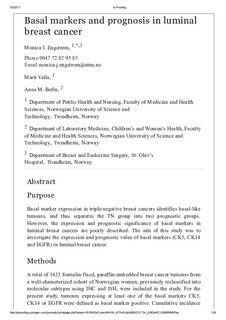| dc.contributor.author | Engstrøm, Monica J | |
| dc.contributor.author | Valla, Marit | |
| dc.contributor.author | Bofin, Anna M. | |
| dc.date.accessioned | 2018-04-30T07:47:42Z | |
| dc.date.available | 2018-04-30T07:47:42Z | |
| dc.date.created | 2017-03-16T14:21:34Z | |
| dc.date.issued | 2017 | |
| dc.identifier.citation | Breast Cancer Research and Treatment. 2017, 163 (2), 207-217. | nb_NO |
| dc.identifier.issn | 0167-6806 | |
| dc.identifier.uri | http://hdl.handle.net/11250/2496463 | |
| dc.description.abstract | Purpose
Basal marker expression in triple-negative breast cancers identifies basal-like tumours, and thus separates the TN group into two prognostic groups. However, the expression and prognostic significance of basal markers in luminal breast cancers are poorly described. The aim of this study was to investigate the expression and prognostic value of basal markers (CK5, CK14 and EGFR) in luminal breast cancer.
Methods
A total of 1423 formalin-fixed, paraffin-embedded breast cancer tumours from a well-characterized cohort of Norwegian women, previously reclassified into molecular subtypes using IHC and ISH, were included in the study. For the present study, tumours expressing at least one of the basal markers CK5, CK14 or EGFR were defined as basal marker positive. Cumulative incidence of death from breast cancer and hazard ratio analyses were used to assess prognosis according to basal marker expression.
Results and conclusion
In total, 470 cases (33.0%) were basal marker positive. A higher proportion of the basal marker-positive tumours were of histopathological grade 3 compared to basal marker negative. For hormone receptor-positive, HER2-negative cases, we found better prognosis for basal marker-positive breast cancer compared to basal marker negative. For all subtypes combined, poorer prognosis for basal marker-negative cases was found in histopathological grade 2 tumours but not among grade 1 and 3. | nb_NO |
| dc.language.iso | eng | nb_NO |
| dc.publisher | Springer Verlag | nb_NO |
| dc.title | Basal markers and prognosis in luminal breast cancer | nb_NO |
| dc.type | Journal article | nb_NO |
| dc.type | Peer reviewed | nb_NO |
| dc.description.version | acceptedVersion | nb_NO |
| dc.source.pagenumber | 207-217 | nb_NO |
| dc.source.volume | 163 | nb_NO |
| dc.source.journal | Breast Cancer Research and Treatment | nb_NO |
| dc.source.issue | 2 | nb_NO |
| dc.identifier.doi | 10.1007/s10549-017-4182-z | |
| dc.identifier.cristin | 1458809 | |
| dc.description.localcode | This is a post-peer-review, pre-copyedit version of an article published in [Breast Cancer Research and Treatment]. The final authenticated version is available online at: https://link.springer.com/article/10.1007%2Fs10549-017-4182-z | nb_NO |
| cristin.unitcode | 194,65,20,0 | |
| cristin.unitcode | 194,65,15,0 | |
| cristin.unitname | Institutt for samfunnsmedisin og sykepleie | |
| cristin.unitname | Institutt for klinisk og molekylær medisin | |
| cristin.ispublished | true | |
| cristin.fulltext | original | |
| cristin.qualitycode | 1 | |
